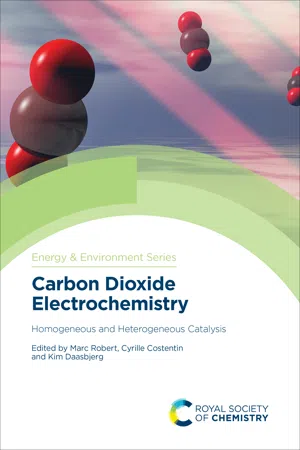![]()
CHAPTER 1
Approaches to Controlling Homogeneous Electrochemical Reduction of Carbon Dioxide
A. JACOB A. BARRETT,*a B. FELIX M. BRUNNER,a C. PO LING CHEUNG,a D. CLIFFORD P. KUBIAK,a E. GWENDOLYENNE L. LEE,a F. CHRISTOPHER J. MILLER,a G. KATE M. WALDIEb AND H. ALMAGUL ZHANAIDAROVAa
a Department of Chemistry and Biochemistry, University of California, San Diego 9500 Gilman Drive, Mail Code 0358, La Jolla, California 92093, USA
b Department of Chemistry and Chemical Biology, Rutgers, The State University of New Jersey, New Brunswick, New Jersey 08903, United States
1.1 Introduction
Carbon dioxide is the end product of combustion and respiration, and its reduction back to energy-rich products has challenged chemists for well over a hundred years. The first reports of the direct electrochemical reduction of CO2 appeared in the early 1900s.1,2 As the field of homogeneous catalysis grew during the 1960s and 1970s, chemists recognized that molecular electrocatalysis was also feasible. The first reports of homogeneous electrochemical reduction of CO2 by molecular catalysts appeared in the 1970s and 1980s. These included metal phthalocyanine complexes,3,4 metal tetraaza-macrocycles,5,6 late metal phosphine complexes,7 and Re (I) bipyridyl carbonyl complexes.8 A molecular electrocatalyst both participates in an electron transfer reaction (at an electrode) and increases the rate of a chemical reaction. In organic electrochemistry, mediators are often used to mediate the flow of charge between an electrode and a chemical substrate, thus acting as an outer sphere electron donor or acceptor toward the substrate.9 An electrocatalyst both supplies charge and performs inner sphere reduction or oxidation of an otherwise kinetically stable substrate. Both the electron transfer and chemical kinetics must be fast for an electrocatalyst to be efficient. Additionally, the electrocatalyst must display a good thermodynamic match between the redox potential (E0) for its electron transfer reaction and the chemical potential difference between the products and reactants (i.e. thermodynamic driving force) for the reaction that is being catalyzed (e.g. reduction of CO2). A significant advantage of molecular electrocatalysis is that these factors can be optimized by chemical tuning of the metal centers via appropriate ligand design.
Over the past ten years, several comprehensive reviews of the homogeneous electrochemical reduction of CO2 have appeared.10–15 In addition to the effects of metal type, d-electron configuration, and ligand type, new dimensions in the performance of molecular catalysts have been identified. Many breakthroughs in our understanding of how molecular catalysts respond to their local environment in the electrochemical cell, e.g. solvent, electrolyte, and applied bias have occurred over the last decade. One example of innovative catalyst design is the use of pendent proton relays, as well as charged and hydrogen bonding groups attached to the catalysts have been reported. This chapter presents much of the new knowledge that has been gained over the past ten years in the homogeneous electrochemical reduction of CO2, with the aim of identifying areas where new research may produce further breakthroughs in our understanding and control of the reduction of CO2 for its conversion to high-value chemicals like CO, formate, methanol, and methane.
1.2 Overview of Parameters for Evaluating Electrocatalysts
This section will give a brief introduction to the parameters commonly used to describe molecular electrochemical catalysis. A more in-depth discussion of these parameters can be found in the ‘Catalyst Comparisons’ section of this text.
Catalytic Tafel plots are used to visualize catalyst performance using the overpotential (η) and turnover frequency (TOF). The overpotential is the additional potential applied beyond the thermodynamically determined potential (E0) required for the electrochemical reaction to transpire. The reaction conditions, such as solvent and pKa of all present proton sources (i.e. water, phenol, or acetic acid), must be considered to appropriately determine E0 of the redox reaction. Furthermore, the products formed (i.e. CO, MgCO3, HCO3−) are considered in the determination of E0cat. Thus, the calculation of overpotential is not trivial but enables the comparison of electrocatalysts under different reaction conditions. The TOF is the number of chemical conversions of the substrate per unit of time (typically in seconds). Catalysts that have a high TOF for a selective transformation with minimal overpotential are ideal.
The catalytic potential for the electron transfer event is reported in several ways. The potential value at the peak catalytic current (E0cat) is typically reported versus a standard electrode potential such as saturated calomel electrode (SCE), silver chloride electrode (Ag/AgCl), or normal hydrogen electrode (NHE). Additionally, this potential may be adjusted based on the redox couple of an internal standard like ferrocene/ferrocenium (Fc+/0). The potential at half the catalytic current (E0cat/2) is normally found at the steepest part of the catalytic wave and may also be reported. The Faradaic efficiency (FE) describes the amount of product produced per number of electrons transferred to facilitate the electrochemical reaction. The following sections will provide many of these parameters for an assortment of electrocatalysts.
1.3 Overview of Metals Utilized in Electrochemical CO2 Reduction
Molecular catalysts can typically be divided into classes based on ligand architecture. Our research group previously described five main classes of catalysts in a 2009 tutorial review published in Chem. Soc. Rev.: metals ligated by porphyrins, cyclams, bipyridyls, polypyridyls, and phosphines.10 This section will briefly recount the molecular catalysts used for electrocatalytic CO2 reduction by Periodic Group in the literature to date.10–15 Improvements in catalytic activity via changes to the metal identity and/or ligand structure, including tuning of the steric and electronic properties, are discussed. The discussion will also describe new strategies for improving catalytic selectivity (i.e. pendent proton relays, Lewis acid additives, hydrogen bonding, and others).
1.3.1 Group 6
The Kubiak and Cowan groups have examined electrocatalytic CO2 reduction with bipyridine complexes of Group 6 metals. The metal tetracarbonyl bipyridyl, [M(R-bpy)(CO)4] (M=Mo, W; R=H, tBu), complexes are active for CO2 reduction with quantitative Faradaic efficiency (FE) for CO at −2.3 V vs. saturated calomel electrode (SCE) [ca. −2.7 V vs. ferrocenium/ferrocene (Fc+/0)] in MeCN.16 The reaction rates are significantly slower than ...
